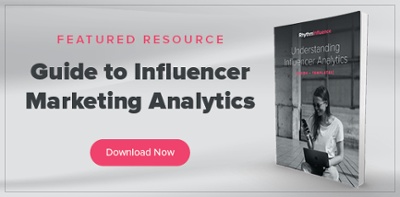During the early stages of every influencer marketing campaign comes a time where strategists have to decide which KPIs to track in order to assess the strengths and weaknesses of the campaign. These KPIs are determined by strategists based on the long term goals of the brand and typically have to do with increasing conversion rates, increasing referral traffic, increasing awareness, increasing audience growth, and increasing engagement.
These are all worthy KPIs that are necessary to document in order to accurately determine if a campaign was a success or not. But amidst all of this increasing there is something a little less tangible, but a little more substantial going on.
We’re talking, of course, about the relationship between the brand and the Influencer. It’s no secret that this relationship is in many ways a partnership. The brand needs the Influencer just like how the Influencer needs the brand. There is an equal transfer of energy, both parties are receiving just as much as they are giving. But what many influencer marketing campaigns get wrong about this partnership is the depth of which it can continue to pay dividends long after the contracted end date of the campaign.
Influencer Brand Partnerships are More than a Transaction
For the most part, the relationship between brands and Influencers is a transactional one. But it is when brands begin to view the relationship as purely transactional, a straightforward payment for a sponsorship, instead of a true partnership, that everyone suffers. And by suffers what I really mean is, when you refuse to embrace the full strength of the brand-Influencer relationship your campaign will not be able to reach its full potential.
Of course, tracking individual influencer KPIs and campaign driven metrics are essential to campaign evaluation and necessary for marketers to be able to optimize future campaigns based on past results, but the partnership is more involved than what we see on paper. And while it’s true that transactional relationships are still partnerships that benefit both parties, these partnerships have the potential to be so much more valuable when you treat them like a true partnership, rather than a one-time transaction. Instead, when the full potential is embraced, brands and Influencers are able to capitalize on the partnership in more sustainable ways in terms of awareness, cost, and trust.
Unexpected Benefits for Brands and Influencers Beyond Campaign Metrics
KPIs are goals that can be aimed for, they are created to keep your campaign or activation on track and designed to deliver marketers with insights that they need in order to better optimize future campaigns. However, when you satisfy your campaign analysis with KPIs alone you are missing out on all of the other benefits that can spring out of brand-Influencer partnerships. These are not-quite goals, but they can be quantified. Think of them as happy accidents, the results of a partnership well maintained. They are unexpected benefits for both brands and the Influencers they work with that are only made possible by a concentrated effort to treat their partnership as the valuable commodity that it is.
Exposure to New Audiences
Before partnering with an Influencer, brands do a lot of homework. They collect all the information about the Influencer that they can, including the demographic makeup of their follower base. This is standard practice for brands. After all, why would you partner with an Influencer who doesn’t have the audience that you want to attract to your brand? However, instead of simply establishing a partnership in an effort to connect with their audience of followers who already fit into the same demographic for your brand’s audience, consider using your partnership to launch your brand’s relationship with an entirely new demographic.
For example, young millennial Influencers are right on the cusp of attracting an audience of millennials and Gen Zers. If you are running a campaign targeted toward millennials with a younger Influencer, don’t neglect that Gen Z following just because you assume they won’t connect with your brand. Instead, when you stay open to connecting with the Gen Z followers you may be surprised by how they react to your brand. Then, once you’re pleasantly surprised by all of the next generation of followers your brand has due to the campaign, you can tweak all future campaigns to be more geared toward your new audience instead of inadvertently neglecting them.
Cross-Platform Promotions
In addition to introducing you to a new demographic, fostering a deeper relationship with your Influencer can also grant you a presence on a previously untapped platform. The reality is, so few Influencers are only active on one platform. For the most part, if an Influencer has a large following on TikTok then they also have a following on Instagram and maybe even Twitter or Snapchat. When partnering with an Influencer who has a large following on multiple platforms, consider running cross-platform promotions to make a name for your brand on a platform that you aren’t already present on.
For example, if you partner with an Influencer with a million followers on both Instagram and TikTok but out of those platforms your brand is only active on Instagram, take your partnership as an opportunity to introduce your brand to TikTok. This way, you can generate twice the engagement with the same content while connecting with a new audience along the way.
The Internet is Forever
In the words of Erica Albright in The Social Network, “The internet isn’t written in pencil, it’s written in ink.” For brands looking for ways to continue profiting off of their Influencer partnerships after their campaigns have ended, this is great news. Because the longevity of the internet lifts all ships, once a brand and Influencer have documented their partnership it will always live on in the mind of the internet. So, what does this mean for brands? Depending on the Influencer you’ve partnered with, it can either be a blessing or a curse.
Source: Today
Ever since 2012 when she became the face of Smart Water, Jennifer Aniston and the brand have been linked and will continue to be linked in the memories of consumers and the internet forever— even though her contract ended in 2020. For the entirety of her career, she will be linked to the brand and the trajectory of her life will be linked to the water bottle company. For Smart Water, this is great news. Jennifer Aniston is not only one of the highest paid actresses to ever be on television, but she has a squeaky clean reputation and therefore reflects positively on the brand.
On the other hand, if a brand partners with an Influencer who goes on to act in an unfavorable way then it could similarly reflect poorly on the brand. While you can’t ensure that the Influencer you’ve chosen to partner with will be as much of an upstanding citizen as Jennifer Aniston, you can make an educated decision about who you enter into partnership with by conducting a thorough influencer vetting process.
Reusable Content
Although the partnership between brand and Influencer could start and end in time with your contract, as mentioned above, due to the longevity of the internet brands can be reaping the fruits of their partnership for years and years after the contract has expired. Especially for brands partnering with nano and micro-influencers, you’ll want to keep an eye on your past partners as they continue to grow their following. Depending on the specifics of your contract, you may be able to reuse their branded content even after your partnership has technically ended.
By creating a partnership with an Influencer rather than treating a sponsored post like a transaction, brands can build partnerships that stretch far beyond the confines of the original activation contract.
Ready to leverage Influencers to help your brand grow? Learn more about the influencer metrics that matter and how they can affect your bottom line with the RhythmInfluence Guide to Influencer Marketing Analytics.



![Influencer Outreach Strategy by Platform [+ Templates!]](https://www.rhythminfluence.com/hubfs/austin-distel-Imc-IoZDMXc-unsplash.jpg)

SUBMIT YOUR COMMENT